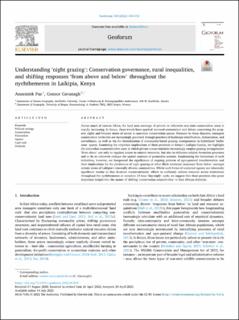| dc.contributor.author | Pas, Annemiek | |
| dc.contributor.author | Cavanagh, Connor Joseph | |
| dc.date.accessioned | 2023-02-23T14:07:28Z | |
| dc.date.available | 2023-02-23T14:07:28Z | |
| dc.date.created | 2022-07-25T14:08:29Z | |
| dc.date.issued | 2022 | |
| dc.identifier.issn | 0016-7185 | |
| dc.identifier.uri | https://hdl.handle.net/11250/3053675 | |
| dc.description.abstract | Across much of eastern Africa, the land area coverage of private or otherwise non-state conservation areas is rapidly increasing. In Kenya, these trends have sparked renewed contestation and debate concerning the property rights and broader terms of access to non-state conservation spaces. Pursuant to these disputes, emergent conservation territories are increasingly governed through practices of landscape stratification, demarcation, and surveillance, as well as via the formalization of community-based grazing arrangements in hybridized ‘buffer zone’ spaces. Examining the empirical implications of these practices in Kenya’s Laikipia County, we highlight the somewhat counterintuitive ways in which private conservationists increasingly employ grazing arrangements ‘from above’ not only to regulate access to natural resources, but also to influence subject formation processes and to fix or otherwise reshape the spatial contours of pastoralist systems. Emphasizing the limitations of such initiatives, however, we foreground the significance of ongoing patterns of agro-pastoral transformation and their implications for the persistence of night grazing or other illicit nocturnal responses ‘from below’ amongst certain strata of Laikipia’s internally diverse communities. Whilst such forms of nocturnal agency are inherently significant insofar as they frustrate conservationists’ efforts to uniformly enforce resource access restrictions throughout the nychthemeron or complete 24-hour ‘day-night’ cycle, we suggest that these practices also grant important insight into the nature of shifting ‘conservation subjectivities’ in East African drylands. | en_US |
| dc.language.iso | eng | en_US |
| dc.publisher | Elsevier | en_US |
| dc.rights | Navngivelse 4.0 Internasjonal | * |
| dc.rights.uri | http://creativecommons.org/licenses/by/4.0/deed.no | * |
| dc.title | Understanding ‘night grazing’: Conservation governance, rural inequalities, and shifting responses ‘from above and below’ throughout the nychthemeron in Laikipia, Kenya | en_US |
| dc.type | Journal article | en_US |
| dc.type | Peer reviewed | en_US |
| dc.description.version | publishedVersion | en_US |
| dc.rights.holder | Copyright 2022 the authors | en_US |
| cristin.ispublished | true | |
| cristin.fulltext | original | |
| cristin.qualitycode | 2 | |
| dc.identifier.doi | 10.1016/j.geoforum.2022.04.015 | |
| dc.identifier.cristin | 2039393 | |
| dc.source.journal | Geoforum | en_US |
| dc.source.pagenumber | 143-153 | en_US |
| dc.identifier.citation | Geoforum. 2022, 134, 143-153. | en_US |
| dc.source.volume | 134 | en_US |

